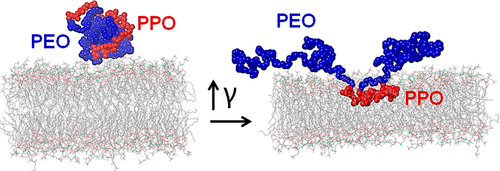当前位置:
X-MOL 学术
›
J. Phys. Chem. B
›
论文详情
Our official English website, www.x-mol.net, welcomes your
feedback! (Note: you will need to create a separate account there.)
All-Atom Molecular Dynamics-Based Analysis of Membrane-Stabilizing Copolymer Interactions with Lipid Bilayers Probed under Constant Surface Tensions
The Journal of Physical Chemistry B ( IF 2.8 ) Pub Date : 2017-11-20 00:00:00 , DOI: 10.1021/acs.jpcb.7b08938 Evelyne M. Houang 1 , Frank S. Bates 2 , Yuk Y. Sham 1, 3, 4 , Joseph M. Metzger 1
The Journal of Physical Chemistry B ( IF 2.8 ) Pub Date : 2017-11-20 00:00:00 , DOI: 10.1021/acs.jpcb.7b08938 Evelyne M. Houang 1 , Frank S. Bates 2 , Yuk Y. Sham 1, 3, 4 , Joseph M. Metzger 1
Affiliation

|
An all-atom phospholipid bilayer and triblock copolymer model was developed for molecular dynamics (MD) studies. These were performed to investigate the mechanism of interaction between membrane-stabilizing triblock copolymer P188 and 1-palmitoyl-2-oleoyl-sn-glycero-3-phosphatidylcholine (POPC) lipid bilayers under applied lateral surface tension (γ) to model membrane mechanical stress. Results showed that P188 insertion is driven by the hydrophobic poly(propylene oxide) (PPO) core and dependent on bilayer area per lipid. Moreover, insertion of P188 increased the bilayer’s resistance to mechanical rupture, as observed by a significant increase in the absolute lateral pressure required to disrupt the bilayer. To further investigate the specific chemical features of P188 underlying membrane stabilizer function, a series of MD simulations with triblock copolymers of the same class as P188 but of varying chemical composition and sizes were performed. Results showed that triblock copolymer insertion into the lipid bilayer is dependent on overall copolymer hydrophobicity, with higher copolymer hydrophobicity requiring a reduced bilayer area per lipid ratio for insertion. Further analysis revealed that the effect of copolymer insertion on membrane mechanical integrity was also dependent on hydrophobicity. Here, P188 insertion significantly increased the absolute apparent lateral pressure required to rupture the POPC bilayer, thereby protecting the membrane against mechanical stress. In marked contrast, highly hydrophobic copolymers decreased the lateral pressure necessary for membrane rupture and thus rendering the membrane significantly more susceptible to mechanical stress. These new in silico findings align with recent experimental findings using synthetic lipid bilayers and in muscle cells in vitro and mouse models in vivo. Collectively, these data underscore the importance of PEO–PPO–PEO copolymer chemical composition in copolymer-based muscle membrane stabilization in vitro and in vivo. All-atom modeling with MD simulations holds promise for investigating novel copolymers with enhanced membrane interacting properties.
中文翻译:

基于全原子分子动力学的膜稳定共聚物与在恒定表面张力下探测的脂质双层相互作用的分析
开发了全原子磷脂双层和三嵌段共聚物模型用于分子动力学(MD)研究。这些进行调查相互作用的膜稳定三嵌段共聚物P188和1-棕榈酰-2-油酰-之间的机构SN-甘油-3-磷脂酰胆碱(POPC)脂质双层在施加的侧向表面张力(γ)下建模膜机械应力。结果表明,P188的插入是由疏水性聚环氧丙烷(PPO)核驱动的,并且取决于每个脂质的双层面积。此外,P188的插入增加了双层对机械破裂的抵抗力,这是通过破坏双层所需的绝对侧向压力的显着增加而观察到的。为了进一步研究P188潜在的膜稳定剂功能的特定化学特征,使用与P188相同类别但化学组成和尺寸不同的三嵌段共聚物进行了一系列MD模拟。结果表明,三嵌段共聚物插入脂质双层的过程取决于共聚物的整体疏水性,具有较高的共聚物疏水性,需要减少每个脂质比率的双层面积以进行插入。进一步的分析表明,共聚物插入对膜机械完整性的影响还取决于疏水性。在此,P188的插入会显着增加破裂POPC双层所需的绝对表观侧向压力,从而保护膜免受机械应力。与之形成鲜明对比的是,高度疏水的共聚物降低了膜破裂所需的侧向压力,从而使膜明显更容易受到机械应力的影响。这些新的 P188插入会显着增加破裂POPC双层所需的绝对表观侧向压力,从而保护膜免受机械应力。与之形成鲜明对比的是,高度疏水的共聚物降低了膜破裂所需的侧向压力,从而使膜明显更容易受到机械应力的影响。这些新的 P188插入会显着增加破裂POPC双层所需的绝对表观侧向压力,从而保护膜免受机械应力。与之形成鲜明对比的是,高度疏水的共聚物降低了膜破裂所需的侧向压力,从而使膜明显更容易受到机械应力的影响。这些新的在计算机模拟中的发现与最近使用合成脂质双层进行的实验发现以及在体外肌肉细胞和体内小鼠模型中的发现相吻合。总体而言,这些数据强调了PEO–PPO–PEO共聚物化学成分在体外和体内基于共聚物的肌膜稳定中的重要性。使用MD模拟进行全原子建模,有望研究具有增强的膜相互作用特性的新型共聚物。
更新日期:2017-11-21
中文翻译:

基于全原子分子动力学的膜稳定共聚物与在恒定表面张力下探测的脂质双层相互作用的分析
开发了全原子磷脂双层和三嵌段共聚物模型用于分子动力学(MD)研究。这些进行调查相互作用的膜稳定三嵌段共聚物P188和1-棕榈酰-2-油酰-之间的机构SN-甘油-3-磷脂酰胆碱(POPC)脂质双层在施加的侧向表面张力(γ)下建模膜机械应力。结果表明,P188的插入是由疏水性聚环氧丙烷(PPO)核驱动的,并且取决于每个脂质的双层面积。此外,P188的插入增加了双层对机械破裂的抵抗力,这是通过破坏双层所需的绝对侧向压力的显着增加而观察到的。为了进一步研究P188潜在的膜稳定剂功能的特定化学特征,使用与P188相同类别但化学组成和尺寸不同的三嵌段共聚物进行了一系列MD模拟。结果表明,三嵌段共聚物插入脂质双层的过程取决于共聚物的整体疏水性,具有较高的共聚物疏水性,需要减少每个脂质比率的双层面积以进行插入。进一步的分析表明,共聚物插入对膜机械完整性的影响还取决于疏水性。在此,P188的插入会显着增加破裂POPC双层所需的绝对表观侧向压力,从而保护膜免受机械应力。与之形成鲜明对比的是,高度疏水的共聚物降低了膜破裂所需的侧向压力,从而使膜明显更容易受到机械应力的影响。这些新的 P188插入会显着增加破裂POPC双层所需的绝对表观侧向压力,从而保护膜免受机械应力。与之形成鲜明对比的是,高度疏水的共聚物降低了膜破裂所需的侧向压力,从而使膜明显更容易受到机械应力的影响。这些新的 P188插入会显着增加破裂POPC双层所需的绝对表观侧向压力,从而保护膜免受机械应力。与之形成鲜明对比的是,高度疏水的共聚物降低了膜破裂所需的侧向压力,从而使膜明显更容易受到机械应力的影响。这些新的在计算机模拟中的发现与最近使用合成脂质双层进行的实验发现以及在体外肌肉细胞和体内小鼠模型中的发现相吻合。总体而言,这些数据强调了PEO–PPO–PEO共聚物化学成分在体外和体内基于共聚物的肌膜稳定中的重要性。使用MD模拟进行全原子建模,有望研究具有增强的膜相互作用特性的新型共聚物。











































 京公网安备 11010802027423号
京公网安备 11010802027423号